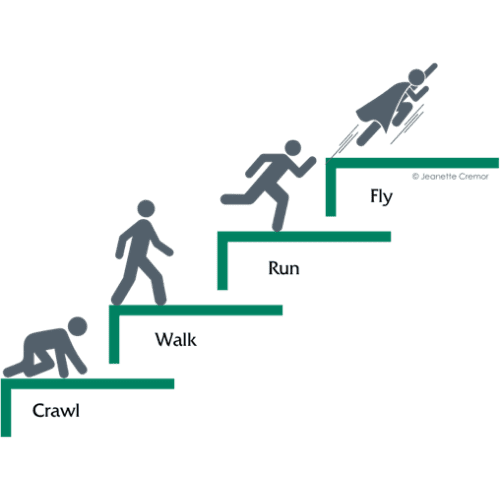The Reality of Business Transformation

Recent Blogs
Leading in the Grey
Why Project Teams should start with curiosity, not connection
Unlearning is the leadership skill nobody talks about
Conflict handled well is a doorway to trust
Life keeps teaching until we listen
When values clash: conflict or opportunity?
Before the Plan, comes the Pause
The First Five Minutes: what your project team vibe reveals
Butterflies before bravery: why leaders overthink tough conversations
Every organisation aspires to transform, whether through digital innovation, process improvements, or cultural change. Project Sponsors invest in new systems, launch ambitious strategies, and set bold goals.
Yet, despite these efforts, transformation initiatives frequently stall—or worse, fail outright. McKinsey reports that 70% of change programs fall short of expectations.
Why? Because transformation isn’t just about strategy—it’s about people.
People don’t move at the same speed. Some charge ahead, eager to implement new ways of working. Others hesitate, feeling overwhelmed or sceptical. And some? They resist entirely, clinging to the comfort of the status quo.
This variation in readiness creates friction. Projects slow down, misalignment grows, and project sponsors become frustrated when momentum stalls.
So, how do we bridge this gap?
Introducing the Crawl-Walk-Run-Fly Model

To navigate transformation successfully, we must recognise that people move through change at different paces. That’s where the Crawl-Walk-Run-Fly model comes in.
It’s a simple but powerful way to assess an organisation’s transformation readiness—and guide teams through each stage.
Let’s break it down.
Crawl – The Hesitation Phase
Problem:
At this phase, resistance is high. Employees are sceptical.
You’ll hear:
“This is just another management fad.”
“We’ve always done it this way.”
“What if it doesn’t work?”
People fear the unknown. They worry about their job security, the impact of change on their workload, or whether leadership will follow through.
Project Leadership Strategy:
- Clearly articulate the why – connect transformation to a compelling reason for change
- Address resistance through open conversations and active listening
- Identify and support early adopters who can influence their peers
- Reinforce small, visible wins to build confidence
Key Message: It’s okay to start slow, but staying here is not an option.
Walk – The Experimentation Phase
Problem:
People start to engage, but uncertainty remains. They want proof that the change will work before fully committing. They are cautiously optimistic but still hesitant.
You’ll hear:
“I see some benefits, but I need more clarity.”
“Can we test this first before going all in?”
“What happens if things go wrong?”
This is where many transformations stall because project sponsors assume initial buy-in means long-term adoption.
Project Leadership Strategy:
- Enable safe experimentation – pilot projects and small test cases work best
- Recognise and celebrate small wins to reinforce confidence
- Create psychological safety – normalise learning from setbacks
- Shift from “convincing” to empowering – let teams discover benefits firsthand
Key Message: Progress is better than perfection. Keep moving forward.
Run – The Acceleration Phase
Problem:
The transformation is gaining momentum, but risks emerge. Teams start running, but not always in sync. Silos develop. Some individuals push ahead while others struggle to keep up.
Challenges include:
- Misalignment across teams – departments work at different speeds
- Lack of structured support – new processes are in place, but not fully embedded
- Burnout risks – momentum creates pressure, and some employees feel overwhelmed
Project Leadership Strategy:
- Shift from explaining why to refining how transformation is implemented
- Strengthen cross-functional collaboration to keep teams aligned
- Empower teams with more autonomy – reduce reliance on top-down direction
- Optimise workflows and remove barriers to adoption
Key Message: You’ve got this! Now, let’s push boundaries.
Fly – The Mastery Phase
Problem:
At this phase, organisations risk complacency. Teams become comfortable with their new ways of working, but without ongoing reinforcement, they may revert to old habits.
Or even worse – leadership assumes the transformation is “done.”
Transformation is not an event. It’s a mindset.
Project Leadership Strategy:
- Foster a culture of continuous improvement and innovation
- Mentor future leaders to sustain transformation beyond leadership changes
- Align transformation efforts with long-term strategic goals
- Capture and share success stories to reinforce best practices
Key Message: Transformation isn’t an endpoint – it’s a way of working.
Why This Model Matters for Project Sponsors
Many organisations fail because they treat transformation as a one-size-fits-all journey. But the reality is:
- Some teams want to run before they crawl – they rush ahead without laying the foundation
- Others stay stuck in crawl – paralysed by uncertainty and resistance
- The strongest transformations happen when leaders guide teams through each phase with the right strategies
This is where real project leadership is tested.
- Do you recognise where your people are today?
- Are you meeting them where they are or forcing them into a one-size-fits-all approach?
- Are you leading them through the crawl, walk, run, and fly phases with clarity, confidence, and commitment?
Transformation isn’t about technology, processes, or strategy alone.
It’s about people.
